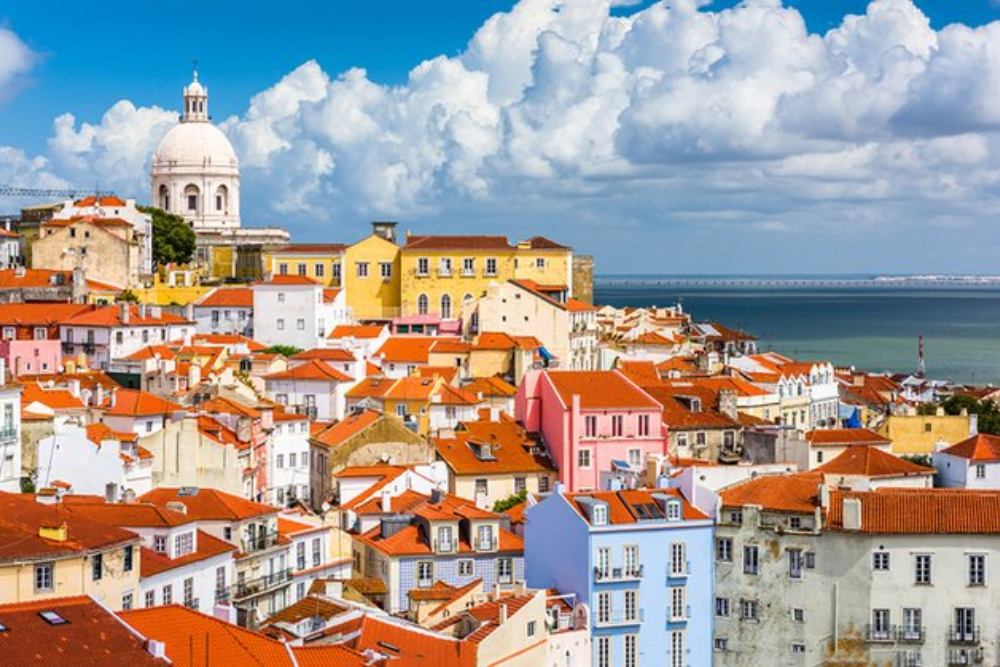Introduction
Portugal is a charming country where old-world traditions blend seamlessly with modern vibrance. From the golden beaches of the Algarve to the cobbled streets of Lisbon and the romantic alleys of Porto, Portugal offers a rich tapestry of culture, history, and natural beauty. Known for its warm hospitality, soulful Fado music, and delicious cuisine—especially pastéis de nata and fresh seafood—Portugal invites travelers to slow down and savor life. Whether you’re exploring ancient castles, sipping Port wine along the Douro River, or catching waves in Nazaré, Portugal is a destination full of soul and sunshine.
Lisbon – The Soulful Capital
Start your journey in Lisbon, a city that feels like poetry in motion. Wander through the historic Alfama district with its narrow alleys, colorful tiles (azulejos), and traditional Fado music echoing from taverns. Ride the iconic Tram 28 through the hills, and enjoy panoramic views from São Jorge Castle or Miradouro da Senhora do Monte. Don’t miss the elegant Belém Tower and Jerónimos Monastery, both UNESCO World Heritage Sites. Lisbon also has a vibrant nightlife, especially in Bairro Alto.
- Sintra – A Fairytale Come True
Just a short train ride from Lisbon lies Sintra, a whimsical town nestled in the mountains. Its crown jewel is Palácio da Pena, a colorful romanticist castle perched atop a hill. Nearby, the Quinta da Regaleira estate is famous for its mysterious gardens, underground tunnels, and the iconic Initiation Well. Sintra’s blend of mystical architecture and lush forests makes it feel like a place out of a storybook.
- Porto – The City of Bridges and Wine
In northern Portugal, Porto enchants visitors with its riverside charm and world-famous Port wine. The historic Ribeira district is a maze of medieval streets lined with cafes and shops, overlooking the Douro River. Walk across the Dom Luís I Bridge for stunning views, and visit wine cellars in Vila Nova de Gaia for tastings. Don’t forget the majestic Livraria Lello, a bookstore said to have inspired J.K. Rowling.
- Douro Valley – A Wine Lover’s Paradise
The Douro Valley, a UNESCO-listed region, is one of Europe’s oldest wine-producing areas. Terraced vineyards cascade down hillsides to the Douro River, creating breathtaking scenery. Take a boat cruise or drive along winding roads for unforgettable views. Visit vineyards and enjoy wine tastings while learning about the centuries-old winemaking tradition.
- Algarve – Sun, Sea, and Stunning Cliffs
Southern Portugal’s Algarve region is famous for its dramatic coastline, charming fishing villages, and golden beaches. Popular spots like Lagos, Albufeira, and Portimão offer everything from nightlife to natural beauty. Benagil Cave, with its natural skylight, is a must-see. Go surfing, paddleboarding, or simply relax along turquoise waters.
- Évora – A Timeless Treasure
In the heart of Alentejo, Évora is a museum-city with Roman ruins, medieval churches, and narrow streets. The Temple of Diana, Évora Cathedral, and the eerie Chapel of Bones (Capela dos Ossos) showcase Portugal’s deep historical roots.
- Madeira & Azores – Island Escapes
For nature lovers, the Portuguese islands of Madeira and the Azores offer dramatic landscapes, volcanic lakes, and hiking trails through lush greenery. Madeira is perfect for levada walks and botanical gardens, while the Azores are ideal for whale watching and geothermal spas.
Dos and Don’ts in Portugal
Dos
- Do greet with a handshake or cheek kisses: A handshake is polite when meeting someone for the first time. Among friends or acquaintances, it’s common to greet with two cheek kisses (starting with the right cheek).
- Do try the local food and drinks: Don’t miss trying bacalhau (salt cod), pastéis de nata, Port wine, and regional dishes. Portuguese cuisine is a big part of the culture.
- Do say “obrigado” or “obrigada”: It means “thank you.” Men say obrigado, and women say obrigada. A little effort in Portuguese is appreciated.
Don’ts
- Don’t assume Spanish is spoken: While Portuguese and Spanish may sound similar, they’re different languages. Speaking Spanish in Portugal can be seen as disrespectful—try English or basic Portuguese phrases.
- Don’t rush your meal
Dining is considered a social and relaxed experience. Don’t expect quick service—it’s not rude, just part of the culture. - Don’t talk politics or colonial history lightly:: Avoid discussing Portugal’s colonial past or sensitive political topics unless you know the person well.
Best time to reach in Portugal
The best time to visit Portugal depends on your interests—but generally, spring (March to May) and autumn (September to October) are ideal for most travelers.
Spring (March to May) – Best Overall
- Why go? Mild weather, blooming landscapes, fewer tourists.
- Perfect for: Sightseeing in cities like Lisbon, Porto, and Sintra; wine tours in the Douro Valley; hiking.
- Bonus: Easter festivals and flower-filled countryside.
Summer (June to August) – Beach Lovers’ Paradise
- Why go? Hot and sunny, perfect for the Algarve’s beaches and island escapes like Madeira.
- Be aware: This is peak season—expect crowds and higher prices.
- Perfect for: Water sports, beach holidays, coastal road trips.
Autumn (September to October) – Wine & Romance
- Why go? Harvest season in wine regions, still warm, fewer tourists.
- Perfect for: Wine tasting in Douro Valley, relaxed city visits, and nature walks.
Winter (November to February) – Quiet & Cozy
- Why go? Fewer crowds, mild winter (especially in southern Portugal).
- Perfect for: Cultural getaways, city breaks, budget travel.
- Bonus: Great time for enjoying Fado music and cozy tavern meals.
